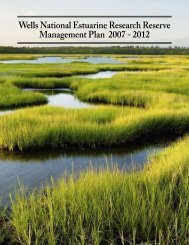inside - Wells National Estuarine Research Reserve
inside - Wells National Estuarine Research Reserve
inside - Wells National Estuarine Research Reserve
Create successful ePaper yourself
Turn your PDF publications into a flip-book with our unique Google optimized e-Paper software.
spring 2011 volume 28 issue 1<br />
development on the health of the Saco<br />
River estuary, and to identify ways to mitigate<br />
those effects.<br />
Sustaining the Saco<br />
The Saco River basin is the largest watershed<br />
in southern Maine, draining about<br />
1,700 square miles and encompassing all or<br />
part of 20 cities and towns in the state. From<br />
its headwaters in the White Mountains of<br />
New Hampshire, Maine’s fourth-largest river<br />
flows roughly 120 miles before emptying<br />
into the Gulf of Maine between the cities of<br />
Biddeford and Saco.<br />
bolstering those efforts by collecting and<br />
analyzing data on the fish that use salt<br />
marshes along the tidal portion of the Saco<br />
River. Last summer, research associates<br />
Jacob Aman and Jeremy Miller led a team<br />
that repeatedly sampled coastal fish using<br />
the marsh surface, with special interest in<br />
migratory species such as river herring, eel,<br />
and tomcod. Their work continues in 2011.<br />
Meanwhile Chris, the social scientist,<br />
focuses on the people of the area and the<br />
places where they live, work, and play. She<br />
is also studying the gaps in scientific knowledge<br />
that prevent certain management<br />
If you get people talking about what makes<br />
the river running through their community<br />
important to them, they discover shared values.<br />
The estuarine portion of the Saco River<br />
extends about 4 miles, from near Cataract<br />
Dam at Factory Island, Biddeford (the most<br />
seaward of the river’s 40-plus dams), to<br />
Camp Ellis and Hills Beach. At the river<br />
mouth lies the UNE campus.<br />
A team of UNE and <strong>Wells</strong> <strong>Reserve</strong> scientists,<br />
along with a number of undergraduate<br />
students from the university, is now studying<br />
the ecology of the Saco River estuary, as<br />
well as the policy, regulation, and economic<br />
influences upon it.<br />
UNE students and their professors are<br />
approaching the project from myriad natural-science<br />
angles — surveying fish in the<br />
river channel, monitoring birds using the estuary<br />
and edge habitats, assessing bacterial<br />
counts in the water, using GIS models to see<br />
how the river’s shoreline could change with<br />
sea-level rise, researching the livelihoods<br />
supported by the estuary, and learning<br />
about salt marsh plant communities.<br />
As a project collaborator, <strong>Wells</strong> <strong>Reserve</strong><br />
research director Dr. Michele Dionne is<br />
and policy questions from being answered<br />
during stakeholder workshops.<br />
Over the course of the 5-year project,<br />
stakeholders will agree upon a way to<br />
regularly monitor and summarize the health<br />
of the Saco River estuary. During the next<br />
several months, the team will be considering<br />
potential tools that might serve as a<br />
sort of “report card” for measuring progress<br />
toward future goals. Already, the Biddeford<br />
Open Space Committee has committed to<br />
using information from the project in the<br />
city’s open space plan.<br />
“Sustaining Quality of Place in the<br />
Saco River Estuary through Community<br />
Based Ecosystem Management” is a 5-year<br />
grant (2009–2014) made to the University<br />
of New England by the <strong>National</strong> Science<br />
Foundation EPSCoR program (Experimental<br />
Program to Stimulate Competitive <strong>Research</strong>)<br />
and administered through the University<br />
of Maine Sustainability Solutions Initiative.<br />
A portion of the funding is shared with the<br />
<strong>Wells</strong> <strong>Reserve</strong>.<br />
5<br />
Saco River<br />
Estuary Project<br />
Principal Investigators<br />
Pamela Morgan, Ph.D.<br />
UNE Environmental Studies<br />
Christine Feurt, Ph.D.<br />
UNE Environmental Studies &<br />
<strong>Wells</strong> NERR Coastal Training<br />
Collaborators<br />
Michele Dionne, Ph.D.<br />
<strong>Wells</strong> NERR<br />
James Sulikowski, Ph.D.<br />
UNE Marine Sciences<br />
Stephen Zeeman, Ph.D.<br />
UNE Marine Sciences<br />
Gregory Zogg, Ph.D.<br />
UNE Biology<br />
Noah Perlut, Ph.D.<br />
UNE Environmental Studies<br />
Michael Daley, Ph.D.<br />
UNE Business and Communications<br />
Stakeholders<br />
Local Residents<br />
City of Biddeford<br />
City of Saco<br />
Saco River Corridor Commission<br />
Saco River Salmon Club<br />
Saco Valley Land Trust<br />
Southern Maine Regional<br />
Planning Commission<br />
Maine Department of<br />
Environmental Protection




